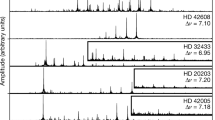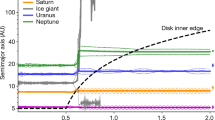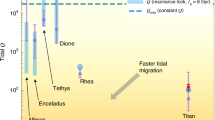Abstract
MANY planets have been shown to have chaotic instabilities in their orbital motions, but the long-term significance of this is not fully understood1. The eccentricity of Mercury, for example, changes by about 25% of its value over 40 times the Lyapunov time2,3(the e-folding time for divergence of nearby orbits), but the orbit of Pluto, in an integration lasting 50 Lyapunov times4, shows no significant change. Here we show that the orbit of the near-Jupiter asteroid 522 Helga is chaotic, with an unusually short Lyapunov time of 6,900 yr. We integrate its motion, including perturbations from the outer giant planets, over a period 1,000 times longer than this, and find no significant instability. Chaos in the orbit of 522 Helga is caused by a 7:12 resonance with the orbit of Jupiter, but the size of the chaotic region in phase space is small; stability is ensured because the eccentricity and precession of the orbit are such that it avoids close encounters with Jupiter. Asteroid orbits with larger proper eccentricity would, we suggest, be genuinely unstable, consistent with the sparse asteroid population near Helga. Although Helga is the first clear-cut example of a stable chaotic orbit, we argue that 'stable chaos' may be a rather common feature of Solar System dynamics.
This is a preview of subscription content, access via your institution
Access options
Subscribe to this journal
Receive 51 print issues and online access
$199.00 per year
only $3.90 per issue
Buy this article
- Purchase on SpringerLink
- Instant access to full article PDF
Prices may be subject to local taxes which are calculated during checkout
Similar content being viewed by others
References
Nobili, A. M. & Burns, J. A. Science 244, 1425 (1989).
Laskar, J. Icarus 88, 266–291 (1990).
Laskar, J. in Chaos et Déterminisme (eds Dahan. A., Chabert, J. L. & Chemla, K.) (Seuil, Paris, in the press).
Wisdom, J. & Holman, M. Astr. J. 102, 1528–1538 (1991).
Milani, A. & Nobili, A. M. Celest. Mech. 34, 343–355 (1984).
Brouwer, D. & Clemence, G. M. Methods of Celestial Mechanics Ch. XVI (Academic, New York, 1961).
Schubart, J. Celest. Mech. 43, 309–317 (1988).
Milani, A. & Knez̆ević, Z. Celest. Mech. 49, 347–411 (1990).
Nobili, A. M. in Asteroids II (eds Binzel, R. P., Geherels, T. & Matthews, M. S.) 862–879 (University of Arizona Press. 1989).
Bevilacqua, R., Menchi, O., Milani, A., Nobili, A. M. & Farinella, P. Moon Planets 22, 141–152 (1980).
Wisdom, J. Icarus 56, 51–74 (1983).
Wisdom, J. Nature 315, 731–733 (1985).
Milani, A. & Nobili, A. M. Astr. Astrophys. 144, 261–274 (1985).
Sussman, G. J. & Wisdom, J. Science 241, 433–437 (1988).
Nobili, A. M., Milani, A. & Carpino, M. Astr. Astrophys. 210, 313–336 (1989).
Laskar, J. Nature 338, 237–238 (1989).
Milani, A., Nobili, A. M. & Carpino, M. Icarus 82, 200–217 (1989).
Author information
Authors and Affiliations
Rights and permissions
About this article
Cite this article
Milani, A., Nobili, A. An example of stable chaos in the Solar System. Nature 357, 569–571 (1992). https://doi.org/10.1038/357569a0
Received:
Accepted:
Issue Date:
DOI: https://doi.org/10.1038/357569a0




